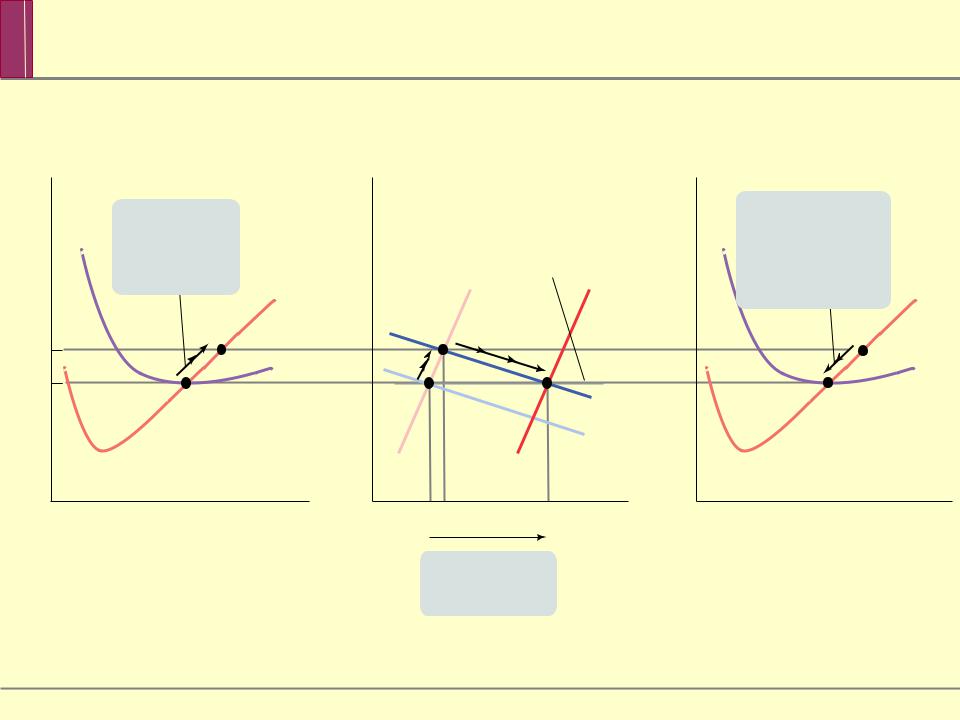
Lectures_micro / Microeconomics_presentation_Chapter_13
.pdf

 The Long-Run Industry Supply Curve
The Long-Run Industry Supply Curve
A market is in long-run market equilibrium when the quantity supplied equals the quantity demanded, given that sufficient time has elapsed for entry into and exit from the industry to occur.

-Run Market
Price, cost of bushel
$26
22
Market price
14
Shut-down price
-run industry curve, S
0 |
200 |
300 |
400 |
500 |
600 |
700 |
Quantity of tomatoes (bushels)


 The Long
The Long
|
Individual Firm |
Price, cost |
cost |
of bushel |
MC |
S |
S |
|
3 |
|
MKT |
MKT
Breakeven price
0 |
750 |
0 |
3 |
6 |
|
tomatoes |
|
|
tomatoes |

in |
an |
Run |
|
Run and |
|
||
|
(b) Short-Run and Long- |
(a) Existing Firm Response |
|
(a) |
Run Market Response |
|
|
to |
to Increase in Demand |
to New Entrants |
|
Price, |
|
Price |
|
|
Price, |
cost |
An increase in |
|
|
Long-run |
cost |
|
|
|
industry |
|
|
|
demand raises |
|
|
|
|
|
|
|
supply |
|
|
|
price and |
|
|
|
|
|
|
|
curve, |
|
|
|
pro!t. |
|
|
|
|
|
|
|
|
|
|
|
|
|
|
D |
|
|
|
|
|
MKT 2 |
|
|
|
|
|
D |
|
|
|
|
|
1 |
|
0 |
Quantity |
0 |
QXQY |
Quantity |
0 |
Higher industry output from new entrants drive price and pro!t back down.
Quantity
Increase in output from new entrants

Comparing the Short-
Industry Supply
Price
Short-run industry supply curve, S
Long-run industry supply curve, LRS
The long-run industry supply curve is always "atter – more elastic than the short-run industry supply curve.
Quantity


 Conclusions
Conclusions
Three conclusions about the cost of production and efficiency in the long-run equilibrium of a perfectly competitive industry:
In a perfectly competitive industry in equilibrium, the value of marginal cost is the same for all firms.
In a perfectly competitive industry with free entry and exit, each firm will have zero economic profits in longrun equilibrium.
The long-run market equilibrium of a perfectly competitive industry is efficient: no mutually beneficial transactions go unexploited.

SUMMARY
1. In a perfectly competitive market all producers are price-taking producers and all consumers are pricetaking consumers.
2. There are two necessary conditions for a perfectly competitive industry: there are many producers, none of whom have a large market share, and the industry produces a standardized product or commodity. A third condition is often satisfied as well: free entry and exit into and from the industry.

SUMMARY
3. A producer chooses output according to the optimal output rule: produce the quantity at which marginal revenue equals marginal cost. For a price-taking firm, marginal revenue is equal to price and its marginal revenue curve is a horizontal line at the market price. It chooses output according to the price-taking firm’s optimal output rule: produce the quantity at which price equals marginal cost.
4. A firm is profitable if total revenue exceeds total cost or, equivalently, if the market price exceeds its break-even price—minimum average total cost.

SUMMARY
5. Fixed cost is irrelevant to the firm’s optimal short-run production decision, which depends on its shut-down price—its minimum average variable cost—and the market price. When the market price is equal to or exceeds the shut-down price, the firm produces the output quantity where marginal cost equals the market price. When the market price falls below the shut-down price, the firm ceases production in the short run. This generates the firm’s short-run individual supply curve.
6. Fixed cost matters over time. If the market price is below minimum average total cost for an extended period of time, firms will exit the industry in the long run. If above, existing firms are profitable and new firms will enter the industry in the long run.

SUMMARY
7. The industry supply curve depends on the time period. The short-run industry supply curve is the industry supply curve given that the number of firms is fixed. The short-run market equilibrium is given by the intersection of the short-run industry supply curve and the demand curve.
8. The long-run industry supply curve is the industry supply curve given sufficient time for entry into and exit from the industry. In the long-run market equilibrium— given by the intersection of the long-run industry supply curve and the demand curve—no producer has an incentive to enter or exit. The long-run industry supply curve is often horizontal. It may slope upward if there is limited supply of an input. It is always more elastic than the short-run industry supply curve.
